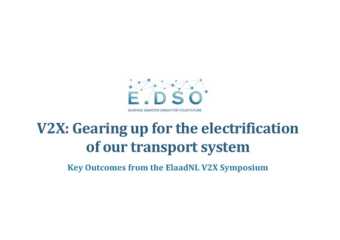Smart charging: integrating a large widespread of electric cars in electricity distribution grids
EDSO explores the questions of what effects does electric vehicle charging have on distribution grids, and how can distribution system operators (DSOs) tackle the integration of the new loads into their networks in a smart way.
One of the key challenges of electric vehicle charging is their potential implications in terms of peak capacity demand, which can happen when all electric cars start to plug in at the same time as soon as the drivers arrive at their destination. The risk is that expensive grid infrastructure investments may need to be made – as depending on the charging time and travel distance, the additional demand can be twice as big as current peak power demand.
By preventing local network congestions, smart charging could combine both flexibility of use and cost savings for customers and DSOs – especially in low-voltage distribution grids where most of the charging is taking place at private driveways or parking lots.
The shift towards a grid-friendly charging behaviour needs to come by way of infrastructural and regulatory improvements. First, achieving a large widespread of electric cars requires that DSOs are able to use smart charging to manage network constraints when this is more cost-efficient than expanding the grid. Smart charging can help to streamline demand for energy by adjusting the charging profiles with the supply for energy and grid capacity.
Further, existing tariffs such as simple time-of-use signals may be used to prompt customers to shift charging at off-peak times, but will not be enough to alleviate congestion longer term. More advanced solutions responding to specific demands of DSOs should be used to ease the strain on distribution grids. These can include dynamic smart charging possibilities through the use of a variable contract offered by the DSOs and combined with the right capacity grid tariff structure, or even buying services from a flexibility market.
For this to happen, evolution must take place inside the grids too: DSOs will need to make use of smarter distribution network tariffs and offer variable contracts incentivising customers to reach charging profiles better adapted to the available grid capacity; better equip and monitor their grids through data available from their networks; as well as invest in new grid tools and methods to better oversee and coordinate network constraints.
Lastly, developments in ICT technology are just as important as infrastructural and regulatory ones: interoperability of data and information between all charging infrastructure and e-mobility management systems is needed to communicate with all parties. Equally important is that interoperable ICT protocols enable seamless communication flows from the DSO to the charging station and its back end system.






